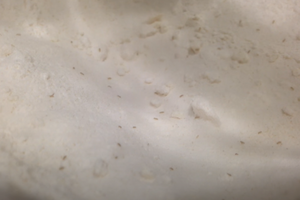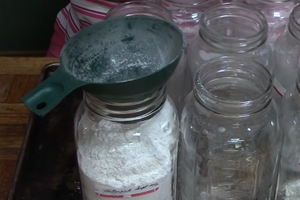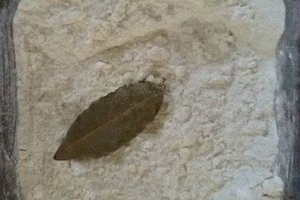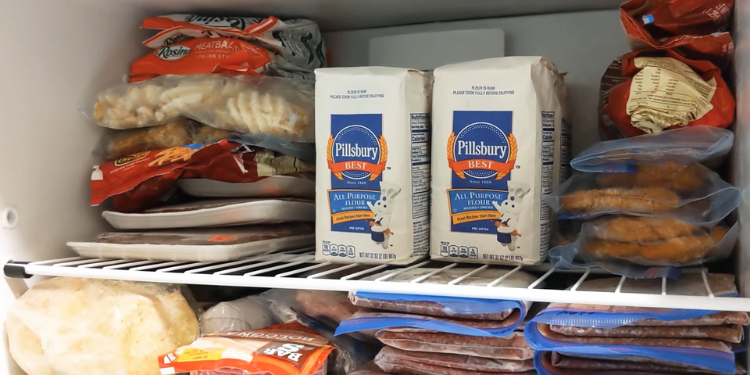Flour is a staple of the kitchen and something that should always be on hand. However, for many people, that large package of flour purchased to make pancakes will sit in the pantry collecting dust, eventually ending up in the trash because it is spoiled.
So how can you store flour to have it on hand when needed without excess waste? There are several ways to store flour safely. Sealing flour in an airtight container, keeping it in the fridge, or freezing it, are all excellent options.
Still, there is much to consider before simply tossing flour into the pantry.
The Benefits Of Freezing Flour
There are many reasons to freeze flour that you are not immediately using. Besides extending the product’s shelf life, freezing flour provides numerous benefits.
Freezing Flour Kills Pests
 Believe it or not, flour is the ideal environment for bugs. Often referred to as pantry pests, tiny, sometimes microscopic creatures will make your dried goods their permanent residence.
Believe it or not, flour is the ideal environment for bugs. Often referred to as pantry pests, tiny, sometimes microscopic creatures will make your dried goods their permanent residence.
A kitchen shelf or pantry is not safe from sneaky bugs looking to make themselves at home, and you may not notice.
⇒ This Bug Will Kill Most Americans During The Next Crisis
Various species of tiny bugs are often found in flour and are known as ‘flour bugs’ or ‘pantry pests.’
Pantry pests infest any dry, stored food and can be found in everything from dried fruits and cereals to pasta, rice, and flour. They are even regularly found living in spices stored in the pantry.
Flour bugs are tiny. Some are so small they can be almost impossible to spot with the naked eye. These unwanted roommates infest with ferocity and damage dried goods with ease. Pantry pests also multiply rapidly and can quickly spread around a home.
Never mind that it is disgusting to think of bugs in your cereal or other dry goods. These itty-bitty bugs will spoil products quickly.
Freezing Flour Makes It Last Longer
Choosing to freeze flour will significantly extend its shelf-life. The average shelf-life of plain white flour is generally between 4-8 months and usually about 6 months.
Corn flour will last longer, around 9-12 months, While rice and potato flour will last as long as regular flour. Whole wheat flour has the shortest shelf-life, lasting approximately 4-6 months, and it is the same for self-rising flour.
Related: Looming Grain Shortage. Do This Before It’s Too Late
 Thankfully, flour can be frozen and stored for up to 2 years. However, if you plan to freeze flour, you must ensure that it is frozen in an airtight or vacuum-sealed container.
Thankfully, flour can be frozen and stored for up to 2 years. However, if you plan to freeze flour, you must ensure that it is frozen in an airtight or vacuum-sealed container.
This will prevent the formation of water droplets that will later melt and moisten the powdered product.
While freezing flour is a handy way of ensuring you have it on hand when required, you must ensure that it is fully defrosted and has come to room temperature before use.
Using cold flour when baking will prevent baked goods from rising and cause them to become rubbery.
Boss-Level Flour Storage Using Mylar Bags With Oxygen Absorbers
If you really want to be the envy of all your flour-storing friends, or you just want to ensure the product maintains optimal freshness, then you may want to consider investing in some mylar storage bags with oxygen absorbers.
These unique storage bags are crafted from a metal-like material. They block light, moisture, and oxygen, keeping your flour or other dried goods safe, secure, and fresh for a long time.
Related: How To Repackage Foods in Mylar Bags With Oxygen Absorbers For Long Term Survival
Alternatively, you can purchase oxygen absorbers that can be added to any resealable storage bag or container to extend shelf life. Using oxygen absorbers in flour storage will significantly increase shelf-life. In fact, this simple addition could mean the product lasts up to 10 years!
Canning Flour
Canning flour is an excellent option, so it is on hand when you need it but stores well for more extended periods.

To can flour, you will want to begin by freezing it to kill off any pests in the original packaging.
As noted, many microscopic pests make their homes in flour, even before you bring it into yours. Freezing flour for 48 hours will kill off these unwelcomed guests.
When canning flour, the process is the same as any other type of food. Using canning jars, lids, a funnel, some paper towels, and oven mitts, you can create batches of flour to store for later use.
Just be sure to clearly date each jar, so you know when it was created. You also want to ensure that the jars are completely dry and moisture-free.
A Leafy Little Trick
When you purchase flour from the grocery store, you will notice it has a “best before” date printed on the packaging. The U.S. Department of Agriculture explains that ‘best before’ or ‘best used by’ dates help consumers and retailers decide when food is of the best quality. These dates are not an indicator of the product’s safety.
Related: Man Eats Expired Food for 365 Days. This Is What Happened
While you can consume flour after the ‘best before’ date and spoiled flour will likely not kill you, it can ruin an otherwise fantastic meal. Thus, to get the best quality and bang for your buck, you want to keep flour fresh as long as possible.

Along with storing flour in an airtight container or freezing it in bulk or batches, another tip that helps increase its shelf-life is bay leaves.
Any long-time baker will tell you adding bay leaves to stored flour will increase the time it remains fresh and ward off pests.
One thing to note is that placing the bay leaves directly into the flour can make it challenging to use the flour when needed without accidentally scooping up part of a leaf.
Related: How to Keep Moisture and Pests Away from Your Food Stockpile
To combat this issue, place the leaves in an open ziplock, or pile them in a measuring spoon that you leave in the container.
How To Tell Flour Is Spoiled
Now that you know how to store flour for an extended period, you should not have to worry about it being spoiled, right?
Not exactly. Even in ideal conditions, the flour will eventually spoil. Determining the freshness of flour is often thought to be tricky, but if you rely on your nose, it is easy as pie.
Spoiled refined flour, such as all-purpose, pastry, or self-rising flours, will give off a sour smell when past its prime. Nut and seed flour, such as flax, almond, or hemp flour, on the other hand, will have a burnt, bitter taste after expiration.
For whole-wheat flour, like wheat, spelt, and barley, there will be a ‘strange’ or ‘rancid’ smell when the product is no longer useable.
Trust your nose and instincts, and do not combine old flour with a new bag, as this will only shorten the shelf life of the entire batch. Flour can benefit from a significant shelf-life when stored correctly, making it an ideal product to have on hand when SHTF.















Wheat bearries in mylar bag
H-dc
Yes, for long term, wheat berries are the best way to store grains.
What else.?
There is more to just having wheat berries. is there more to your post that you left out. ?
Should we freeze it or will it be okay as is.
Know that we have that wheat, now what. Can you give more info.
Just wondering.
No need go freeze it. Mylar bag o2 absorbers.
Get a good grain mill
Jeeeeus Christ – an entire article on a bullshit wive’s tale >>> freezing will kill bug larva !!!!!!
try using a little common sense – if freezing killed off bug larva – the entire northern hemisphere of the planet would be bug free – hate to disillusion the true believers – but the bugs don’t migrate for the winter with the birds …
the grain crop grown in the north goes into grainery and silo storage – sits for MONTHS in the sub-freezing – adding a few days in the home freezer hardly matters …
what does happen – preppers that believe the tale don’t allow for a total unfreezing – don’t compensate for the added humidity >>>> develop mold in their long term food stores
use the long term storage method that utilizes 02 absorbers in a mylar bag and food grade bucket >>> the low 02 environment not only is the best method for preserving – it also prevents bug larva birthing >>> two for one advantange
thank you!
If you are talking about “whole grain berries”, and the grain is very hard at that time, so no bugs can harm the berries like they can processed flour, then I will agree, but this article is talking about processed flour and yes freezing the flour will kill the bugs left in the flour. A Bay leaf will help.
If for some reason that you did not, nor could afford mylar bags, then I see no reason to not put the flour in the freezer to just see if it will help prolong any infestation of bugs, aka pantry pest.
We have to try every possible way that we can think of, to prolong all food, the best way we can, even if it’s a wife’s tale.
This is a good article for someone, but not you. that’s okay… It’s not for everyone…
The article did talk about mylar bags and O2 absorbers.
Stay sharp
love how you re-write biology and entomology – and throw stupidity at the food processors to boot >>> again – if freezing would actually kill the larva – don’t you think a FED agency like the FDA would REQUIRE the freezing of processed flour at the mills????
you absolutely need to submit your resume to Biden – he needs your way of solving problems ….
What a joke you are.
Believe the FDA . You are a good followers.
And how old are you . What 12 yrs old. What’s with the Biden remark. Can’t just be a man and finish your post with out your childish remarks.
That’s why NO ONE takes you serious.
Lol
No need for mylar bags if your going to use oxygen absorbers. One or the other is fine. But 02 food grade buckets is definitely a go.
Aside from abusing the name of the Lord, maybe you shouldn’t post while drunk.
Keeping flour IN the Freezer until being used WILL indeed protect that flour from bug infestation.
Long term storage, really? The Sockpuppet is trying for WW3 and your worried about 20+ year storage?
Get your canned goods ready folks, Winter is coming.
talking about drunk – try reading what the OP posted – not what your penis infection fever suggests >>> he’s 100% proposing nothing but a continual of modern folklore >>> which actually is both potentially harmful and dangerous – you freeze and try thawing in high humidity I guarantee too high a moisture content for LTS packing – GOD will only help you if you eat mold bound food ….
Ephesians 4:30
Illini Warrior is only one that’s responded with correct information, so far . I’ve stated the same thing on other sites . I’m very disappointed at the large number of really stupid answers on this site on most articles I’ve read . People that inappropriate are not ones that I would want around after shtf in my circle .
Guy – I FIGHT this stupidity every single time it crops up – there’s a few more Prepper Wive’s Tales that won’t die – love the “science” behind the whole testing of Faraday cages ….
I believe this whole freezing BS got started by the misunderstanding of using freezing to kill ACTIVE bugs in contaminated food – allows for eazy sifting of the dead critters and saving the food …..
You haven’t said shit about anything.
You really are a joke. Lmao at you.
I was on the USS Enterprise from 1965-1968 and we were eating bread/rolls & baked goods from flour that had been stored in warehouses from 1948 through the late 1950’s. It had weevils and larva in the flour that had hatched out. We go used to it and just picked the cooked critters out and ate the bread. Even after being stored for over 40 years the flour was not bad. It took 3 tours and the ship’s mess cooks baking 15,000 meals a day to finally get into newer stored flour. Package it, seal it and forget about it. Unless it’s self-rising flour, it will last a long time.
The military is a shit hole that let the sailors drink fuel for water
Nobody should join this trailer. Trash war losing military
Sift the flour in a fine mesh colander before use… would at least sift the large bugs out. Not sure if you use the sifters that have moving parts inside that the moving parts might/would/could squish those bugs fine enough to become part of the flour you would use. The fine mesh colander might be better at preventing that.
We have had these bugs.
At first, we thought they were just drain flies, but quickly became more than a nuisance.
Bisquick, flour, and oatmeal in the large can were all whisked to the freezer, as well as unopened packages.
Took us a while to figure it out.
Now partially used packages of grain product go into ziplock bags.
This seems to have solved the problem.
Currently, fresh picked garden vegetables, especially tomatoes, seem to be a source.
10 minutes soaked in a gallon of water and a cap full of bleach seems to be effective.
I use organic whole wheat flour which I order in 10 lb. bags six at a time twice a year. The flour comes in heavy brown paper bags. If you put the bags of flour in the freezer they absorb moisture and cause the flour to clump. So all i do is put the bags of flour into plastic garbage bags and then into the freezer. The flour keeps good with no clumping or bugs.I don’t store flour for more than six months. However we experimented years ago growing wheat on our farm . We even thrashed it with a faile. It was stored in plastic five gallon buckets in a cool dry place. The last of the wheat is twenty years old and we feed it to the hens . We also planted some to see what would happen? The wheat berries grew after being stored twenty years> We are getting old so probably won’t grow more wheat but if I want to store flour longer than six months it will be wheat berries not flour. Wheat berries and a hand mill, yeast and water and you will have all the fresh bread you want.
I thought it might be fun to try to grow some wheat myself and process it……. FUN? we planted only a 10’x10′ plot got a great yield. I was hoping to get enough for a few loaves of bread. It is a lot of work. Nice to know we could but buying the wheat berries is the way to go.
This reads like another post thrown together by a third world blogger who scraped together clips from other articles.
I have what berries in the paper feed mill sacks i bought it in several years ago. Its still fine. If the mill in my area were still open I’d buy more. I just store it in a shed. It will still sprout, grow, or grind into flour and is great. I have solar power and an electric mill as well as a hand cranked mill. I like a mix of whole berries and sprouted berries x redried to grind. It adds a deeper more complex flavor to breads. I use homemade sourdough starters and commercial yeast. All great. I also grind millet, rice, and other mixes of wild grains.
I plan to plant wheat in the spring. See how it does here. Millet grows great here. And I like all the grains as sprouts to use green as well.
I put a stick of spearmint gum in each bag of my stored flour & grains. The bugs hate it & stay away! Much easier than bay leaf to find when using the flour. My (depression-era) mom taught me this trick & I haven’t had a single pantry bug since!
Socalnomo
Thank you for sharing.
With age hopefully comes wisdom!
Most of the folks who lived through the Great Depression sadly are gone. My grandparents & my wife’s grandparents lived through the depression and always stored their flour and cake mixes in the freezer. We never thought to ask why…but probably should have…it was just something they did. I’m sure they would have had a very good reason and would have shared if we would have only ask.
Thank you for the info.
We dry can, def kills the bugs, then store in glass jars or vacuum sealed Mylar with correct size oxygen absorber.
RR You’re an idiot…..
I store all purpose white flour in 1 or 1/2 gallon glass jars. It goes in my pantry on a shop cart i keep there. No direct sunlight, cool area, I usually keep flour for one year there. Whole wheat i store for 6 months. Corn meal up to 6 months there. No special care. Just jar it when I buy or grind my grains. Whole grains are in paper feed sacks sewn shut in a cool dark storage area.
Rice, millet, and pasta are all stored alike. Buggy flour is sifted as used in a fine strainer. Rice and pasta if buggy are stored outside to prevent contamination or newer products. Then rinsed when used or fed to my critters. Don’t be so finicky. You do realize cocoa powder, flour, pasta ingredients, etc are all allowed a set amount of bugs and rodent hair. My home stored food is subject to all the same possible storage problems but I’m cleaner and more careful than commercial warehouses.
I learned to wash buggy Rice from my father. A dietitian. We then dried it either in the oven on low heat or over a floor register on rimmed cookie sheets. Food was fine. We just disposed of the extra protein. In a starvation situation I might leave in the protein.
Why throw out the extra protein just cook it and eat!
Don’t forget that you can add food grade DE (diatomaceous earth) to protect flour for storage !!!!
About 1.5-2 teaspoons per pound for any dry grains/flour/legumes/rice/corn
It helps deter bugs (kills them dead) absorbs moisture and is all natural
Just be careful when handling it because it can damage your lungs if you breathe it in
Fireswamp,
Thanks for the info, but do you mix the DE in with the grain? Does it lay on the bottom of the container? Do you rinse it off when you’re going to use it?
I love the information given in all the posts, but if people would do start to finish, that would be even more helpful.
Thanks for the info, much appreciated!!
Nico
You can dust it via layers
So put a coating on bottom of container add a few inches of dry food coat with a thin layer of DE dust
Then close container and shake to mix ( you want to coat lightly the grains or items) then apply thin dusting on top and seal
Read up on food grade diatomaceous earth -it’s very useful
Nico,
I hear you and I have been doing a lot of research myself. It seems to me that…
1) get your flour (all of any you like) and put it into freezer bags approximately the same size, if not slightly smaller than your mylar and/or food saver bags.
2) freeze the bags for at least 48 hrs. I’m going to do up to 3 days.
2a) I wouldn’t open the bags once the freezing is done. You don’t want to give a chance for new bugs to lay anything. Just a thoughtful consideration
3) take the frozen ziplocks out of the freezer and thaw them to make sure there’s no moisture trapped. Slip a new oxygen absorber or 2 into each bag and put the ziplocks full of pre-frozen flour into your mylar or food saver bags and seal them. Store the finished product in bins (like rubbermaid) as apparently, rodents and other vermin are able to smell the food through the bags and will like ruin all your hard work.
Best of luck to everyone out there. Stay safe. Stay strong. Stay focused on what’s important. And above all, God Bless each one of you. See you on the other side
Vote vote vote, vote those scum bags OUT…
Killing bugs with freezing isn’t a one size fits all, though it will cut back on an infestation. Be aware that the freezing will kill off many bugs but not always affect the eggs. They go from egg, larva, pupa then the actual weevil. Some people will take the trouble of freezing to kill the adults, defrosting the flour long enough to hatch the eggs and then freezing again. The freezing has to be long enough to get inside the middle of the batch of flour so smaller bags work out better.
The reason why bugs survive winters in cold climates is because they find those places to hide under tree bark, under house siding, etc.
The concept of using diatomaceous earth or bay leaves are great ideas. Thank you to those who mentioned them.
Put flour into quart jars, similar to canning. drop in a small piece of dry ice. place cap/lid on jar.
put rings on just enough to feel resistance.
Dry ice will evaporate to CO2, carbon dioxide driving out air and
oxygen. pressure will drive out the air after about an hour tighten rings to seal
the jars.. No oxygen means no bugs can breath or live.
A little more trouble but longer lasting.
Instead of taking up all your room in the freezer – just can the flour or pack it in mylar with an oxygen absorber and that’ll kill off any larvae or bugs.
So how long will bread flower keep in Mylar with 02 absorbers? These articles are of little use with that information.
Use dry canning method it is so much better and the flour will be good for 20+ years
Place dry quart jars in oven for an hour at 225° then fill the sterilized jars with flour then put the back in the oven for an hour at 225° and then put your lids in a pie pan with it for another 15 min and get hot. Then take them put 1 it a time and clean wipe rim with dry towel and place canning lid on with ring and tighten and set aside. Do for all jars and within an hour then lids will pop down and give a vacuum seal and the heat from the oven kills off Any bugs and larva.
But, But, But……………………….Bill Gates says we can just eat those bugs!